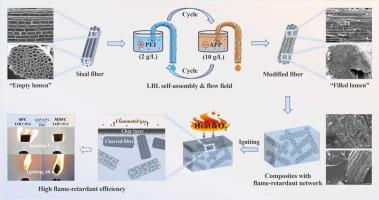仿生流场阻燃改性剑麻纤维及其聚丙烯复合材料
IF 6.2
1区 农林科学
Q1 AGRICULTURAL ENGINEERING
引用次数: 0
摘要
剑麻纤维的管腔为装载阻燃剂和构建三维阻燃网络提供了良好的空间,有效地提高了其聚合物复合材料的阻燃性。本研究将植物纤维的水分/养分转运机制与逐层自组装技术相结合,创新了仿生流场阻燃改性方法,成功地将聚磷酸铵(APP)和聚乙烯亚胺(PEI)沉积到麻麻纤维管腔中。经20次循环改性后,纤维中阻燃剂含量提高到18.36 wt%。其TG残渣由17.35 %(未改性)提高到43.23 %,其限氧指数(LOI)由20.7 %(未改性)提高到39.1 %。与直接将纤维浸泡在APP/PEI溶液中相比,该方法减轻了阻燃剂在管腔入口的堵塞,实现了在管腔内部的均匀沉积。当该改性纤维与聚丙烯(PP)以30 wt%(阻燃剂含量仅为4.65 wt%)共混时,复合TG残渣由3.10 %(未改性)增加到15.77 %,LOI值由19.4 %(未改性)增加到23.2 %。该复合材料的阻燃性能也优于直接分散在PP基体中的APP/PEI (TG残留11.10 %,LOI值21.1 %)。剑麻纤维聚合物复合材料采用纤维腔作为阻燃载体,可有效提高其阻燃性能。所携带的阻燃剂抑制了易燃剑麻纤维的燃烧,所构建的阻燃网络限制了PP基体的燃烧。本文章由计算机程序翻译,如有差异,请以英文原文为准。

Biomimetic flow field flame retardant modification of sisal fiber and its polypropylene composites
The lumen of sisal fiber provides a good space for loading flame retardants and constructing a three-dimensional flame-retardant network, effectively improving the flame retardancy of their polymer composites. In this study, we combined water/nutrient transport mechanism of plant fiber with layer-by-layer self-assembly technology, innovated a biomimetic flow field flame retardant modification method and successfully deposited ammonium polyphosphate (APP) and polyethyleneimine (PEI) into sisal fiber lumen. After 20 cycles modification, the flame retardants in fiber increased to 18.36 wt%. Its TG residue achieved to 43.23 % from 17.35 % (unmodified) and its limited oxygen index (LOI) value achieved to 39.1 % from 20.7 % (unmodified). Compared to directly immersing fiber in APP/PEI solution, this method mitigated the blockage of flame retardants at lumen entrance and realized a uniformly deposition in lumen interior. When blending this modified fiber with polypropylene (PP) at 30 wt% (the flame retardant content is only about 4.65 wt%), the composite TG residue increased from 3.10 % (unmodified) to 15.77 %, and its LOI value increased from 19.4 % (unmodified) to 23.2 %. This composites also has better flame retardancy than APP/PEI directly dispersed in PP matrix (TG residues 11.10 %, LOI value 21.1 %). For sisal fiber polymer composites, employing fiber lumen as flame retardant carrier could improve its flame retardancy efficiently. The carried flame retardants inhibit the combustion of flammable sisal fiber, and the constructed flame-retardant network restrict PP matrix combustion.
求助全文
通过发布文献求助,成功后即可免费获取论文全文。
去求助
来源期刊

Industrial Crops and Products
农林科学-农业工程
CiteScore
9.50
自引率
8.50%
发文量
1518
审稿时长
43 days
期刊介绍:
Industrial Crops and Products is an International Journal publishing academic and industrial research on industrial (defined as non-food/non-feed) crops and products. Papers concern both crop-oriented and bio-based materials from crops-oriented research, and should be of interest to an international audience, hypothesis driven, and where comparisons are made statistics performed.
 求助内容:
求助内容: 应助结果提醒方式:
应助结果提醒方式:


